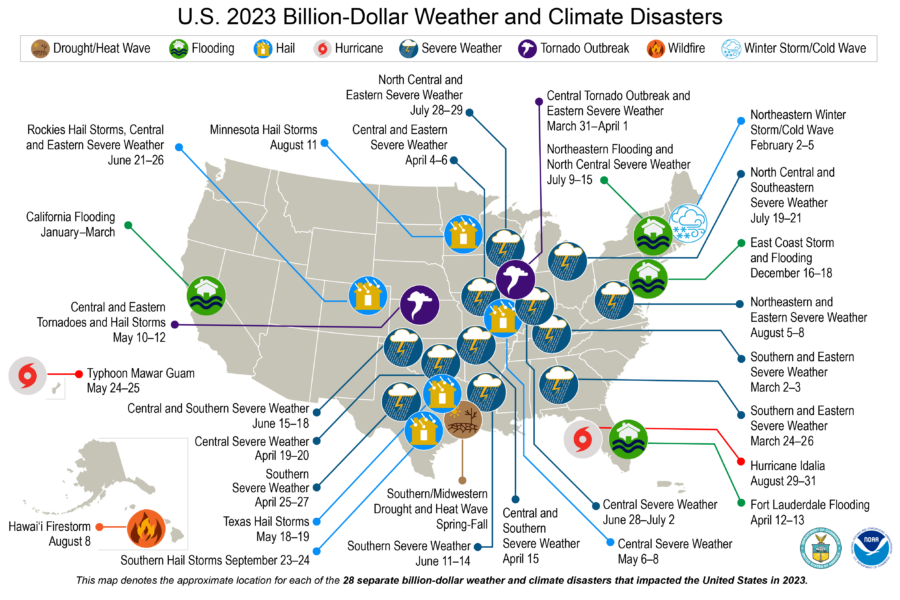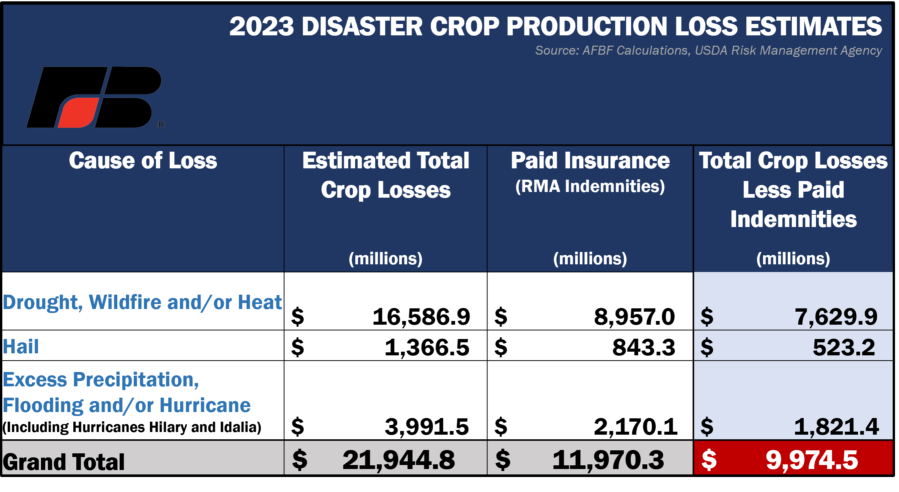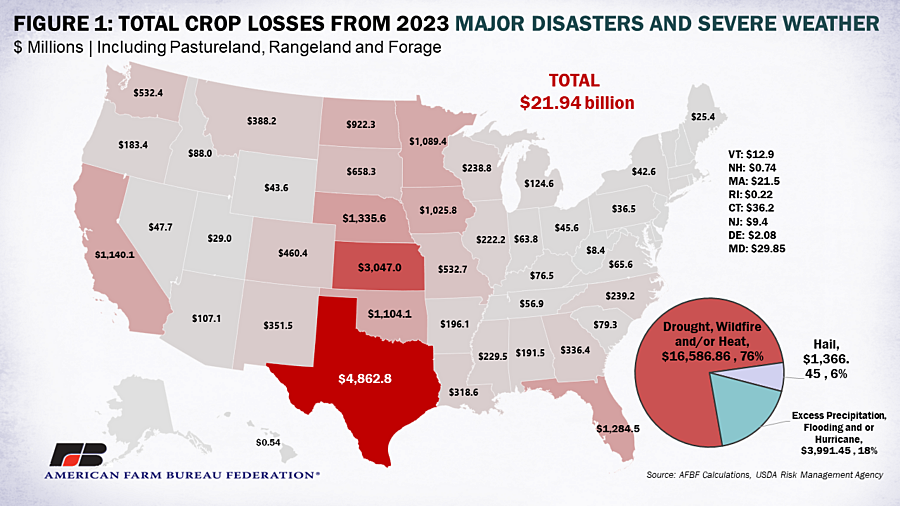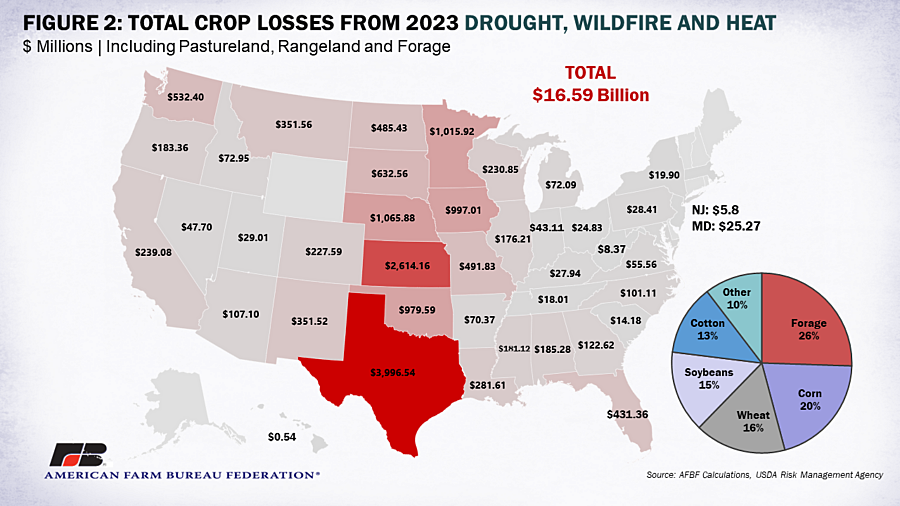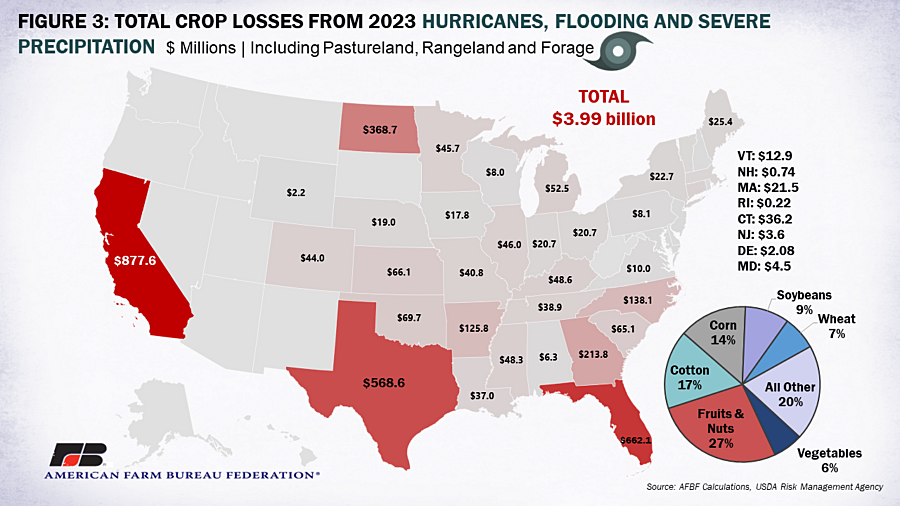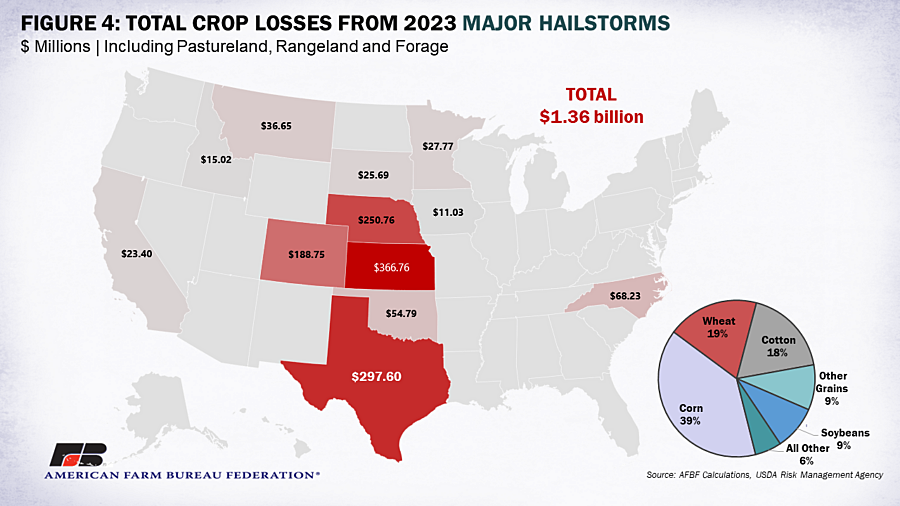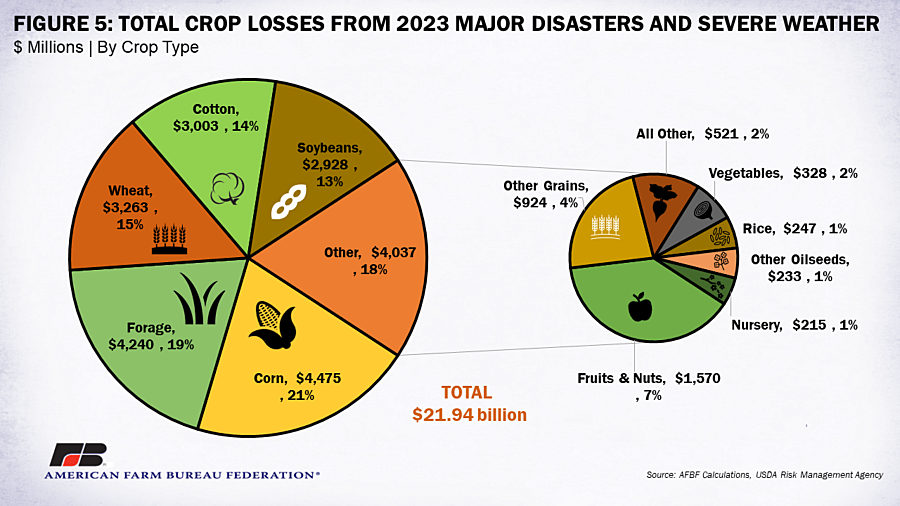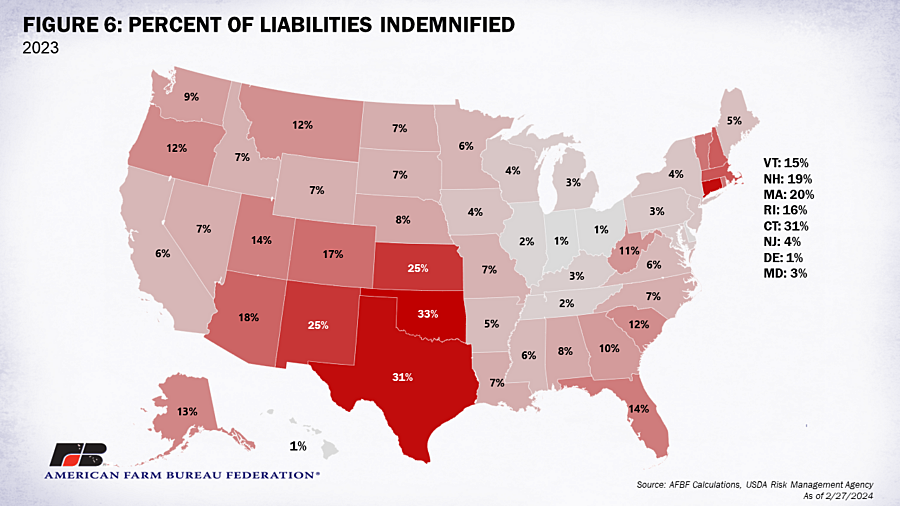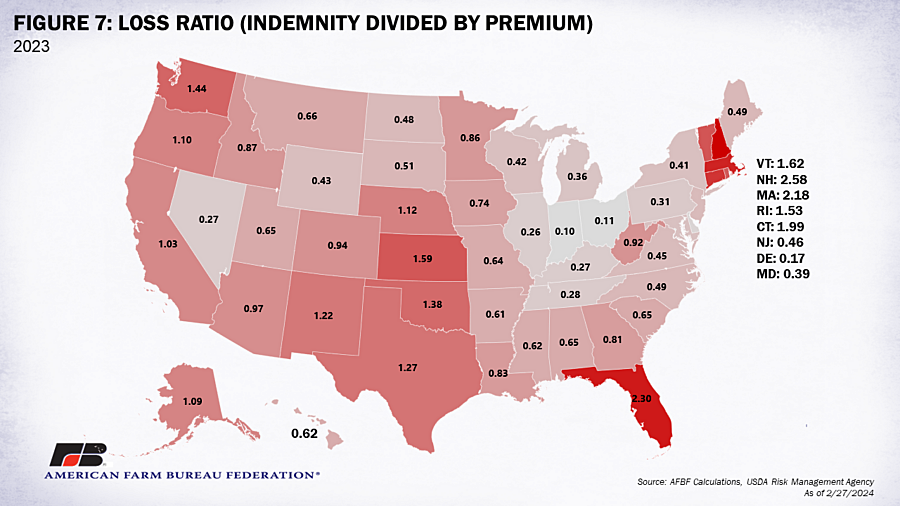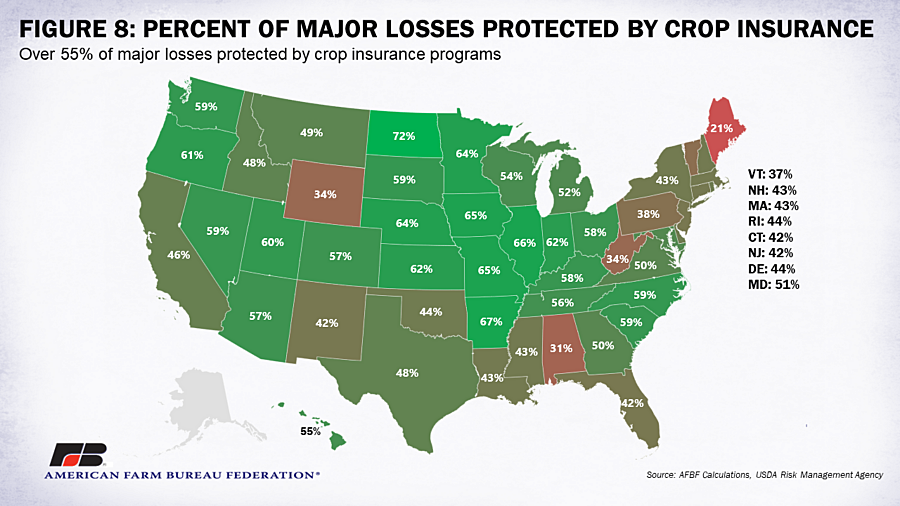Major Disasters and Severe Weather Caused Over $21 Billion in Crop Losses in 2023
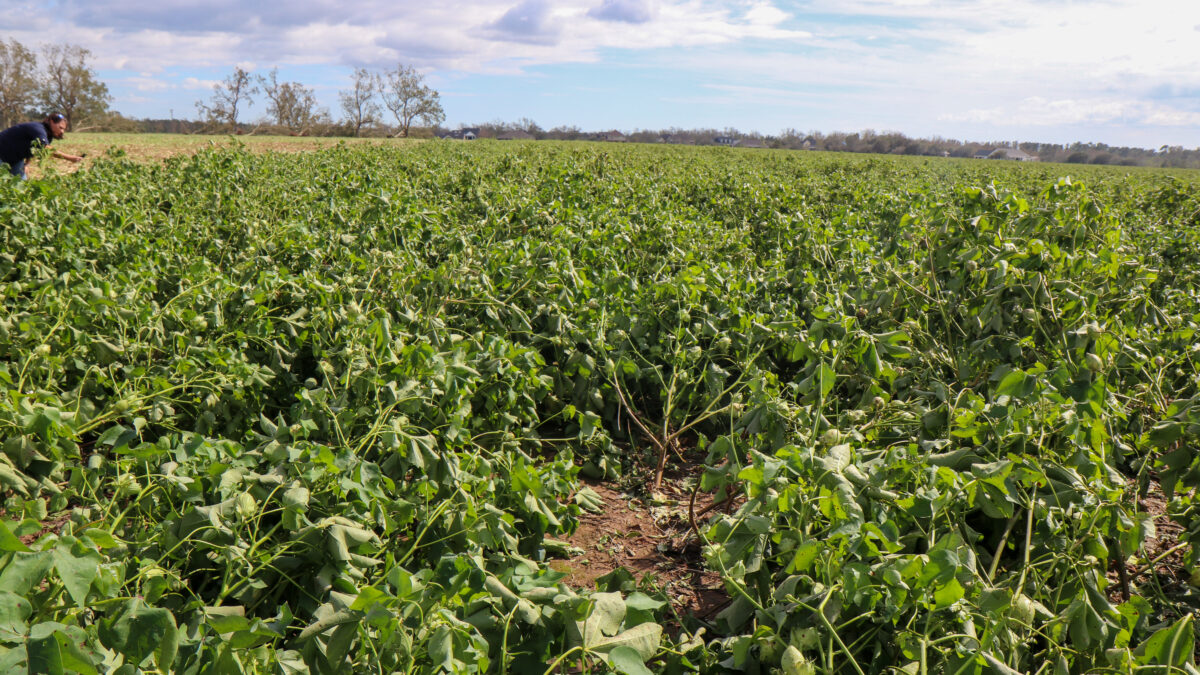
photo credit: Alabama Farmers Federation, Used with Permission
Daniel Munch
Economist
AFBF’s Market Intel team has created a series highlighting agricultural losses incurred due to weather disasters and the disaster assistance programs meant to help mitigate their impacts. Previous articles include: 2020 Disasters Reveal Gaps in Ad Hoc Aid Legislation; Continuing Resolution Extends Disaster Coverage for Most 2020 and 2021 Losses; Kentucky, Arkansas Tornadoes, Midwest Derecho Renew Calls for Timely Disaster Assistance; 2021 Disaster Estimations Reveal at Least $12.5 Billion in Crop and Forage Losses; From WHIP+ to ERP: A New Name for 2020-2021 Ad Hoc Disaster Assistance; New Estimates Reveal Major 2022 Weather Disasters Caused Over $21 Billion in Crop Losses; Severe Weather and Low Mississippi River Levels Bring Uncertainty to Harvest; and Farmers Can Expect Limited Disaster Support from the Latest ERP Reboot.
AFBF has calculated crop and rangeland damage estimates since 2021 to provide a window into the impacts of natural disasters on domestic food production. This Market Intel updates total crop loss estimates across major weather events for 2023. Methodologies between 2022 and 2023 were changed slightly to cover more disaster events. Totals between years are not directly comparable. The methodology for these calculations is described at the end of this article.
Weather-associated production risk is a part of life for farmers and ranchers. Through heavy rain, hail, snow, winds and drought, farming families prepare land, plant and harvest knowing their livelihoods are reliant on local weather conditions. In 2023, 28 weather disasters, each with damages exceeding $1 billion, struck the U.S. coast-to-coast. The National Oceanic and Atmospheric Administration (NOAA) reported that 2023 ranked ninth in terms of the total inflation-adjusted economic impact of these events, with industries across the economy experiencing an estimated $92.9 billion hit (compared to $178.9 billion in 2022). With over 490 lives lost, these disasters will haunt impacted communities for years to come.
Updated crop and rangeland damage estimations for 2023 show the impacts of natural disasters on domestic farm production. The assessment puts total crop and rangeland losses from major 2023 disasters at over $21.94 billion, or 23.6% of NOAA’s total economic impact figure. Of that figure, nearly $12 billion in losses were covered by existing Risk Management Agency (RMA) programs as of February 2024. Nearly $10 billion in losses were not insured through RMA, existed outside policies’ coverage levels, or did not qualify under an existing risk management program. Drought, excessive heat and wildfires alone accounted for over $16.59 billion in total crop losses; $3.99 billion was linked to excessive precipitation, flooding and hurricane events; and $1.37 billion was caused by hailstorms.
AFBF crop loss estimates do not include infrastructure damage, livestock losses, complete horticulture crop losses or timber losses associated with the selected weather events. Estimates should be viewed as a minimum baseline since data to estimate these other categories are not readily available. More comprehensive analysis on individual storms may be available from local land-grant universities. For instance, Louisiana State University estimated $1.69 billion in agricultural losses from excessive heat and drought in the state, which was linked to more granular survey data and far exceeds our estimated $318 million Louisiana total. LSU’s estimate includes comprehensive livestock, timber and more accurate specialty crop baselines that aren’t included in this analysis.
In 2023, Texas suffered the most significant hit for the second year in a row, with over $4.8 billion in incurred losses primarily made up of $2.3 billion in damages to cotton, $1.5 billion in damages to forage and rangeland and $408 million in wheat damage. Close to 80% of Texas losses were attributed to widespread exceptional drought conditions and the remainder were linked to Tropical Storm Harold, flooding and hailstorms. Kansas ranked second with over $3.04 billion in incurred losses, mainly from drought conditions and hailstorms. Kansas wheat losses totaled over $1 billion, followed by $780 million in soybean losses. Corn valued at nearly $605 million also succumbed to drought conditions in Kansas. Nebraska’s losses mirrored those of its southern neighbor, with damages totaling more than $1.3 billion, over $900 million of which was linked to drought and $250 million of which was linked to hailstorms in May. Florida ranked fourth in 2023, claiming over $1.2 billion in crop losses. Losses linked to Hurricane Idalia, flooding and other precipitation events in the state accounted for over 65% of Florida’s calculation. This included over $430 million in fruits and nuts, $130 million in vegetables and $214 million in nursey losses. Drought and extreme heat conditions also contributed to losses in Florida. Figures 2, 3 and 4 show state-by-state crop losses by cause of loss category.
Figure 5 displays overall crop losses by type across all major weather events in 2023. The other grains category includes crops like oats and sorghum, the other oilseeds category includes canola, mustard, flaxseed, etc. and the all other category includes miscellaneous crops like tobacco, sugarcane, sugar beets and mint. As the geographic footprint of drought conditions shifted between 2022 and 2023, so did the impact on crops. In 2022, drought plagued much of the Western U.S., resulting in more pasture and rangeland losses ($6.3 billion in 2022 compared to $4.2 billion in 2023). In 2023, drought shifted and was more prevalent across the central Plains and down to the Gulf Coast, moving corn losses into the first-place spot over forage and bumping soybeans losses up by about $740 million. Wheat losses increased by about $620 million, primarily driven by drought in Kansas, Oklahoma and Texas. Cotton losses remained a bit above $3 billion as drought persisted in Texas’ cotton-growing regions. Hurricane impacts on both California and Florida moved fruit and nuts losses from $400 million in 2022 to nearly $1.6 billion in 2023. This included over $350 million in orange losses primarily in Florida, over $220 million in California grape and table grape losses and over $200 million in California almond losses.
An understanding of the impact of weather disasters on U.S. agricultural production can be gained through several other statistics. The first is the percentage of total liabilities indemnified in each state. Liabilities indemnified refers to the percent of the value of crops insured that was paid out through insurance claims. A lower percentage implies lower production losses that year or very high insured acreage values, while a higher percentage implies higher production losses or very low insured acreage values. Nationally, in 2023, 7% of insured liabilities were indemnified (compared to 11% in 2022 and 7% in 2021). Figure 6 shows the variation in liabilities indemnified by state, revealing which regions had the largest percentage of their insured acreage impacted by weather events. Oklahoma and Texas led with over 30% of liabilities indemnified linked to drought. New England states like Connecticut, Massachusetts, Vermont and New Hampshire ranked very high – a result of extreme flooding that battered the region and a larger percentage of their production in July 2023.
The loss ratio, or the comparison of premiums received by insurers versus payments they made for claims, highlights the performance of insurance plans in a region. As of February 2024, the national loss ratio for 2023 was 0.83, meaning for every $1 spent on premiums, insurers were paying out 83 cents – a positive return for insurers. In 2022, the national loss ratio was 1.05 meaning for every $1 spent on premiums insurers were paying out $1.05 – a negative return for insurers. States with the highest loss ratios in 2023 signal where weather disasters resulted in significant insurance payouts. New England faced the highest loss ratios for the year, with New Hampshire at 2.58 and Massachusetts at 2.18. Florida was the only other state with a loss ratio over 2 in 2023. It is important to note in a national loss ratio that the substantial acreage concentrated in states with lower loss ratios (Indiana, Illinois, Ohio) balances out states that have fewer acres of protected ag land but may have faced higher proportional losses.
Traditionally, federal crop insurance programs are the preferred mechanism for managing risk associated with weather-related disasters for most agricultural products. These policies provide protection from yield losses, increased costs and revenue declines, as well as very timely payment. Unanticipated disaster situations like large-scale weather events pose the optimal test for these programs as disaster relief, designed as they are to provide targeted risk management under more probable and common loss conditions. Losses that occur outside the scope of these conditions and the specified terms of a policy complicate farmers’ ability to qualify for indemnity payments. For some specialty crops, like strawberries, lettuce and hazelnuts, RMA options are unavailable and other programs, like the Noninsured Crop Disaster Assistance Program, often fall short.
Notably, in 2023 over 55% of crop losses from the analyzed disasters were protected through crop insurance. This ranged from a low of 21% in Maine to a high of 72% and 67% in South Dakota and Arkansas, respectively. States with a higher concentration of row crop production generally benefit from better access to crop insurance options, resulting in more acreage being insured at higher coverage levels. States with more specialty crops and/or weaker assumed familiarity with crop insurance options had much lower rates of insured acreage and lower protection in place generally (Figure 6). Gaps in coverage highlight opportunities for improvements to crop insurance and disaster assistance programs.
Congress has often responded through ad hoc disaster assistance programs to fill gaps in existing risk management programs during periods of extreme disasters. On Oct. 27, 2023, USDA announced that some commodity and specialty crop producers impacted by natural disasters in 2022 would be eligible to receive emergency relief payments to offset crop yield and value losses through a modified continuation of the Emergency Relief Program (ERP). The allocation of $3 billion in funds, however, pales in comparison to the $10.4 billion gap in crop loss coverage estimated by AFBF for 2022 losses, meaning many farmers will go without assistance until support is expanded. Additionally, the program’s new progressive factoring methodology reallocates support to a small percentage of operations, a puzzling approach when natural disasters devastate operations of all types. No ad hoc support has been allocated thus far for farmers who faced losses in 2023, meaning the waiting continues. Further discussion of existing farm bill disaster programs and recent ad hoc authorizations can be found here.
Conclusion
Weather-related disasters in 2023 pummeled farms and ranches across the United States, leaving over $21.9 billion in crop and rangeland losses in their wake. Over half of those losses were effectively protected under existing risk management programs, with the remainder highlighting the importance of inclusive protections for growers of all crops in all regions of the nation. Not to mention, the full extent of damage across the sector is likely far higher when livestock, infrastructure, timber and other ag-related factors are considered. The stability of U.S. farms and ranches relies on their ability to be resilient under an array of weather conditions. The farm bill provides lawmakers a chance to fill gaps in existing risk management programs, providing similar risk management opportunities for farmers regardless of what they grow. The sure and timely payments associated with crop insurance and other farm bill programs are often critical for farm-level stability, and ultimately for a safe and secure domestic food supply.
Methodology
To begin, AFBF economists compiled a list of states impacted by weather events in 2023 that would have qualified for ERP. All D2-D4 droughts, hurricanes and wildfires were included. This year, hailstorms and excessive precipitation events were also included given their role in many of NOAA’s billion-dollar weather disasters. Affected states were selected using the National Drought Mitigation Center’s U.S. Drought Monitor and the Federal Emergency Management Agency’s presidential disaster list. States that had any form of D2-D4 drought were automatically included in the analysis. States that suffered one or more of the weather events that qualify for ERP, had a billion-dollar weather disaster as reported by NOAA and or had a presidential-declared disaster were also included in the analysis.
The analysis utilizes RMA crop insurance data to estimate losses if all crop acreage was insured with complete (100%) protection. Methodologies mimic those used by NOAA’s National Climatic Data Center to estimate losses in their annual “Billion Dollar Climate and Weather Disasters” reports (first described in Smith, Katz 2011).
RMA reports on total indemnities (total insurance compensation) paid for each cause of loss (drought, hurricane, flooding, fire, excess moisture, hot wind, etc.) in a given month for each crop type by state. Each storm is defined with a set of cause of loss types based on the weather event and its related conditions covered by ERP. For instance, for hurricanes, the following causes of loss filters were included: excess moisture/precipitation/rain, flooding, hurricane/tropical depression and wind/excess wind. Data was also filtered by the month(s) the storm impacted each state. Once indemnity payments for crops were totaled, adjustments were made for losses outside insured acreage and coverage levels.
This is achieved by first calculating the percent of insured acres in each state (using 2022 data from USDA’s National Agricultural Statistics Service and 2023 RMA summary of business data). It is assumed all acreage of a given crop within a state has been equally impacted by a particular disaster. Then RMA coverage level data is used to find the average coverage rate for each crop in each state. Based on these stats, a factor approach defined as 1/ [(% acres insured) (average coverage level %)] is utilized to come up with a multiplier to estimate 100% of losses. This was repeated for crops in each affected state and totaled.
Using a real-life example: In Florida, 56% of pepper acreage was insured in 2020. Of the covered pepper acreage in Florida, insurance covered an average of 62% of losses. Following the formula described above, Florida pepper indemnities were multiplied by 1/(0.56*0.62), or 2.88, to estimate 100% of losses.
Additional related loss estimates were calculated using reported indemnities paid out under code 55, or the “ARPI/SCO/STAX/MP/HIP WI Crops Only” RMA cause of loss category. RMA is unable to differentiate the cause of loss for indemnities paid out under code 55, therefore it is assumed all losses to “pasture, rangeland, forage” were due to a qualifying disaster in the month(s) the disaster took place. Pasture, rangeland and forage acreage coverage was calculated using national Natural Resources Conservation Service private rangeland estimates.
Top Issues
VIEW ALL